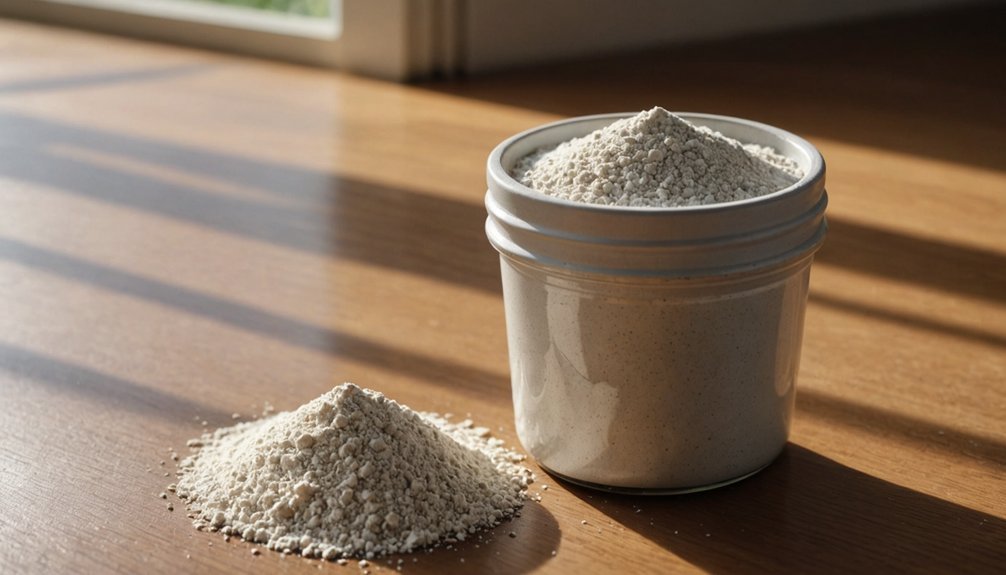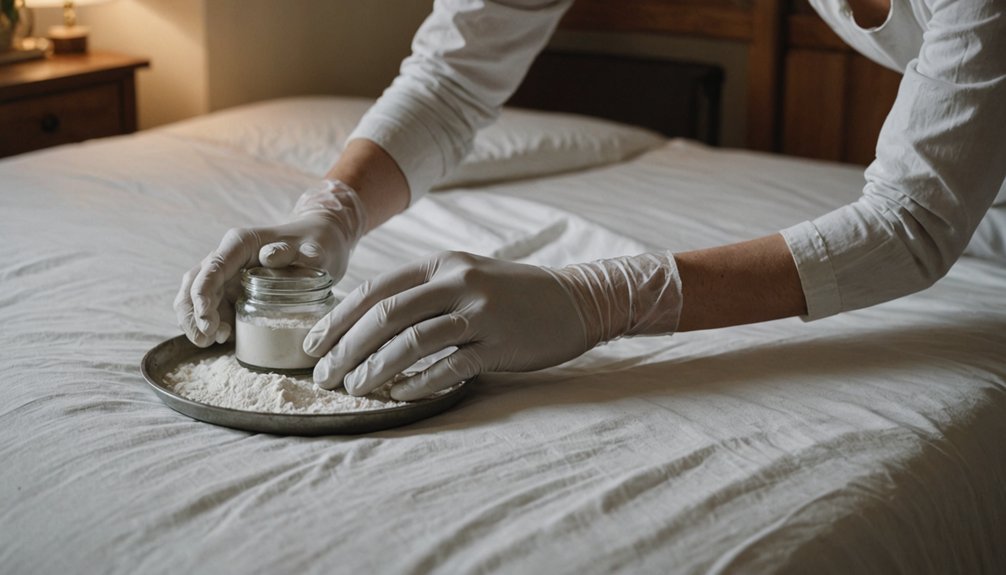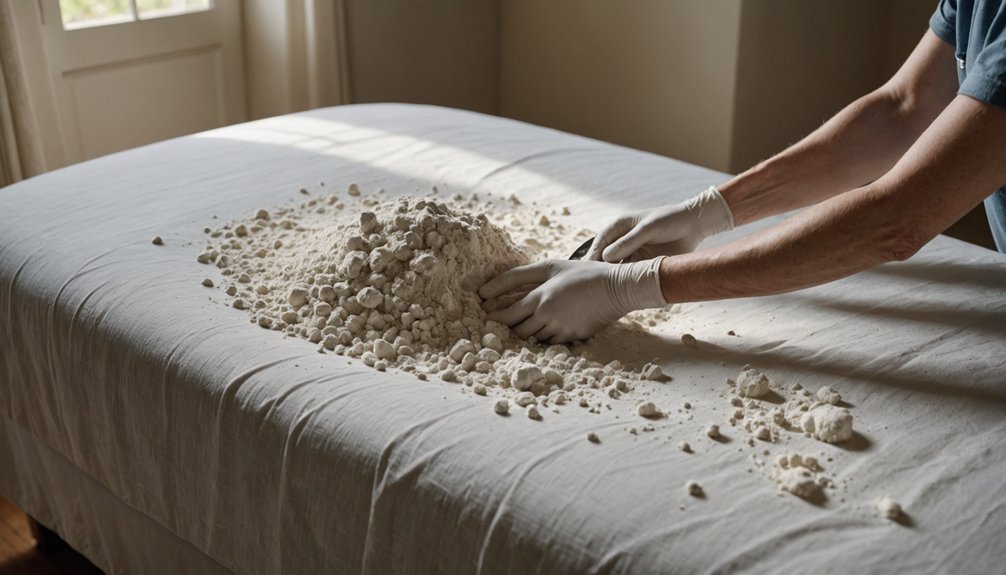Diatomaceous Earth for Bed Bugs: Safe Application Guide
If you’re battling bed bugs, you’ll want to contemplate diatomaceous earth (DE) as your natural weapon of choice. This powdery substance can effectively eliminate these persistent pests without harsh chemicals, but proper application is essential for success. While DE’s bed bug-fighting power is well-documented, many homeowners make significant mistakes that reduce its effectiveness. Let’s explore how you can harness DE’s full potential while keeping your household safe.
Key Takeaways
- Wear protective equipment including a NIOSH-approved respirator, safety goggles, and gloves when applying diatomaceous earth to prevent inhalation risks.
- Apply a thin layer of food-grade diatomaceous earth along mattress seams, bed frames, baseboards, and furniture joints where bugs hide.
- Create proper ventilation by opening windows and using fans during application, and maintain airflow for several hours afterward.
- Reapply diatomaceous earth every 7-15 days to target newly hatched bed bugs and maintain effectiveness of the treatment.
- Monitor treated areas regularly and inspect within 15-20 feet of sleeping areas, focusing on mattress seams and bed frames.
Understanding How Diatomaceous Earth Works

When you examine diatomaceous earth (DE) under a microscope, you’ll find it consists of countless fossilized diatoms – microscopic algae with hardened silica walls.
These tiny organisms appear as hollow, perforated tubes that form a fine, off-white powder resembling talcum powder but with razor-sharp edges.
DE works by physically destroying bed bugs rather than poisoning them.
When bed bugs crawl through the powder, DE’s microscopic shards lacerate their protective waxy coating and abrade their exoskeletons.
This damage causes the insects to lose essential moisture through their damaged outer layer.
Additionally, if bed bugs ingest DE, it absorbs their internal fluids.
This double action of external cuts and internal dehydration leads to their death within 9-15 days of exposure.
The food-grade version is the safest choice for home bed bug treatment, as it poses minimal risk to humans and pets.
Essential Safety Precautions Before Application

You’ll need proper protective equipment, including a NIOSH-approved respirator, safety goggles, and gloves, before handling diatomaceous earth to prevent harmful inhalation and irritation.
Set up adequate ventilation in your indoor treatment area by opening windows and using fans to direct airflow outside, which helps minimize floating dust particles.
Make sure your workspace has proper lighting so you can see where you’re applying the DE while maintaining safety protocols.
Since diatomaceous earth contains silicon dioxide, you should avoid creating excess dust during application to minimize exposure risks.
Protective Equipment Requirements
Proper protective equipment is essential when handling diatomaceous earth for bed bug treatment.
You’ll need a NIOSH-approved N95 respirator or higher to protect your lungs from fine dust particles. Make sure it fits snugly to prevent dust leakage while you work.
Protect your eyes with safety goggles or sealed glasses, and don’t wear contact lenses during application.
You’ll also need long sleeves and nitrile or latex gloves to prevent skin irritation. Consider using barrier cream for extra skin protection if you’re sensitive to irritants.
Keep your protective gear on throughout the entire application process, and remove it carefully outdoors when you’re done.
Clean reusable equipment according to manufacturer guidelines and wash your hands thoroughly after completing the treatment.
Working in a well-ventilated area is crucial for safe application of the product.
Indoor Ventilation Setup
Before applying diatomaceous earth, establishing effective indoor ventilation is essential for safety and treatment success.
You’ll need to set up exhaust fans and position windows strategically to create cross-ventilation throughout the room. Consider using portable HEPA air purifiers to capture dust particles and reduce airborne exposure.
Start ventilation before application and maintain it during and several hours after treatment to allow proper dust settling. Always wear appropriate PPE equipment during setup and application for personal safety.
Don’t use forced air heating or cooling systems, as they can spread dust to untreated areas. Instead, use oscillating fans to circulate air safely.
Monitor humidity levels since high moisture can decrease the treatment’s effectiveness.
Remember to keep electrical equipment away from treated surfaces and seal off any ventilation intakes to prevent contamination of your HVAC system.
Step-by-Step Application Process

Successful application of diatomaceous earth requires a methodical approach that targets bed bugs’ common hiding spots.
Begin by applying a light dusting along your mattress seams, edges, and tufts, being careful not to powder the entire surface. Use your duster or bulb applicator to treat cracks, crevices, baseboards, bed frames, and furniture joints where bed bugs travel.
For wider cracks, push the DE deeper using a spatula or duster. Don’t apply DE directly to pillows, bed linens, or upholstered furniture to minimize exposure. Always wear a dust mask while applying diatomaceous earth to protect yourself from inhalation.
After 7 to 15 days, you’ll need to reapply the treatment to address any newly hatched bed bugs. Remember to maintain consistent coverage in targeted areas while avoiding excessive application that could create unnecessary dust in your living space.
Best Areas for DE Treatment
Identifying the right locations for diatomaceous earth maximizes its effectiveness against bed bugs.
You’ll want to focus on areas where these pests frequently travel and hide, such as wall moldings, baseboards, and the edges of carpets. Apply DE along mattress seams, bed frames, and headboards, as these are prime feeding zones.
Don’t forget to treat furniture joints, particularly in dressers and nightstands near sleeping areas.
Target the spaces behind electrical outlet plates and under appliances, but exercise caution around electrical components.
While treating, avoid areas with high moisture or frequent human contact, as these conditions reduce DE’s effectiveness.
Instead, concentrate on undisturbed spaces like storage closets and the underside of box springs where bed bugs commonly harbor.
Monitoring and Maintenance After Application
You’ll need a thorough monitoring strategy to guarantee your DE treatment remains effective, which includes regular visual inspections, bed bug interceptor checks, and documentation of any bug activity.
Keep your treated areas in top condition by reapplying DE when it becomes damp or disturbed, and maintain proper bed isolation practices to prevent bed bug movement.
Schedule follow-up inspections for at least 10 weeks post-treatment, using consistent monitoring methods to track the success of your bed bug control efforts.
Regular Inspection Protocol
To maintain the effectiveness of diatomaceous earth treatment against bed bugs, regular inspections must become part of your ongoing pest control strategy. Focus your inspections within 15-20 feet of sleeping areas, checking mattresses, box springs, bed frames, and nearby furniture. Use a flashlight angled along surfaces to spot eggs and newly hatched bugs, and don’t forget to probe cracks and crevices with tools like putty knives or playing cards.
| Inspection Area | What to Look For |
|---|---|
| Mattress Seams | Eggs, live bugs, fecal stains |
| Box Springs | Shed skins, hiding adults |
| Bed Frames | Bugs in joints and cracks |
| Baseboards | Population clusters, powder disturbance |
| Nearby Furniture | Signs of spreading infestation |
Conduct weekly checks for the first 4-6 weeks after treatment, then monthly for several months. Keep detailed notes of your findings to track progress and identify areas needing retreatment.
Post-Treatment Cleaning Schedule
Proper timing plays an essential role in your post-treatment cleaning schedule after applying diatomaceous earth for bed bugs.
You’ll need to leave DE in place for 14-15 days to guarantee it kills all bugs and newly hatched eggs. During this period, avoid wet cleaning methods or vacuuming, as moisture will render the DE ineffective.
Once the waiting period ends, use a shop vac or vacuum with a HEPA filter to remove the DE residue and bed bug debris.
Clean slowly and thoroughly, paying special attention to mattresses, carpets, and hard-to-reach areas. Seal and dispose of vacuum bags outside your home to prevent reinfestation.
Keep monitoring the treated areas for several weeks after cleaning, looking for signs of live bugs or new activity. If you spot any, you’ll need to reapply treatment.
Long-Term Prevention Steps
Maintaining long-term bed bug control requires a systematic approach to monitoring and prevention after your initial diatomaceous earth application.
Conduct weekly visual inspections of sleeping areas, focusing on mattress seams, bed frames, and nearby furniture. Place interceptor traps under bed legs and check them every two weeks. Keep detailed records of any bed bug activity you observe to track patterns and determine when you’ll need to reapply treatments.
You’ll need to maintain a clutter-free environment and vacuum frequently to reduce potential hiding spots. Wash bedding at high temperatures (above 140°F) regularly, and seal any cracks in walls or furniture.
Reapply diatomaceous earth every 2-3 weeks, particularly around bed frames and baseboards, but don’t over-apply. If you continue seeing bed bug activity despite these measures, consult a professional pest control service.
Combining DE With Other Treatment Methods
While diatomaceous earth (DE) works effectively on its own, combining it strategically with other bed bug treatments can greatly boost your success rate.
You’ll need to carefully plan your integrated approach to maximize each method’s strengths while avoiding counterproductive interactions.
- Start by vacuuming thoroughly and using steam treatment on mattresses and furniture – once surfaces are completely dry, apply DE to cracks and crevices.
- Use chemical sprays on mattresses and encasements while reserving DE for undisturbed areas where it can remain dry.
- Install mattress encasements and interceptor traps, then create DE barriers around bed legs and baseboards.
- Consider using essential oils as repellents to drive bugs toward DE-treated areas, but never mix oils directly with DE or apply them to the same spots.
Conclusion
You’ll find diatomaceous earth to be a reliable ally in your fight against bed bugs when you follow proper safety protocols and application methods. Remember to maintain consistent treatment cycles, monitor infested areas regularly, and combine DE with other control methods for maximum effectiveness. While it’s not an overnight solution, your dedication to proper DE application will lead to long-term bed bug control success.

